Atlanta Braves 2016-2017 Top 100 Prospects: 11-20

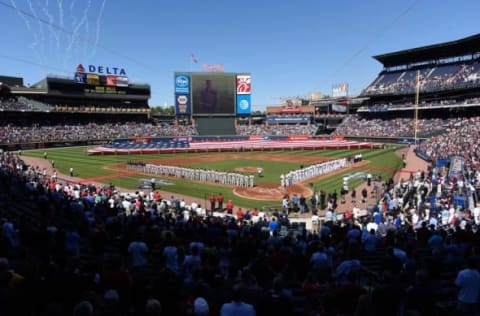
The Atlanta Braves have an incredible farm system, and Benjamin Chase has taken up Tomahawk Take’s minor league coverage of that system. This is his top 100 prospects in the Atlanta Braves system!
An Introduction
This is my second undertaking of an Atlanta Braves Top 100 Prospects list.
I will be honest – it was much tougher this season. Last year, I did consider just under 150 names that I considered as worthy of being on the top 100 list, but the qualifications were basically “did not look bad statistically” or “heard at least one positive thing”.
This year I knew was going to be much deeper, so I upped my personal requirements even for consideration, and I had 173 names on the initial list that I made to start sorting out from.
First, the methodology. This list is not a list of the guys who have the most talent from 1-100 as that wouldn’t tell us what we really want to know. This is an evaluation of who has the talent, the mental makeup, and the work ethic to turn their talent into a major league baseball player.
The reality is that of these 100 players, the Braves would be doing exceptionally well if 25 of them played more than a brief stint with the major league club. That part does need to be kept in mind as we continue through this list.
That does not mean that someone who is a #98 on this list can’t have a major league career. What I look at is the level of impact a player will have IF he does make the major leagues. A guy who will be an impact hitter or not make it at all will likely get rated higher than a guy who won’t make it as a starter or a late-inning reliever, but he has a good shot to be a major league middle reliever.
All players who have not exceeded rookie requirements are eligible for this list, even if they’ve played in the major leagues already.
I will have a post on Friday after the entire list is revealed that presents the list in a pure list format with no evaluation on each player for reference in the future. These posts will have more in-depth evaluation of each player in the list.
I also intend to update this list sometime before spring training begins with any off season acquisitions that the Braves make, so I won’t be updating the list as each trade/rule V pick/waiver claim is made, it will all be at that time.
With that said, let’s take a look at this post’s focus, #11-20 on the list!
Next: #20 & #19
20. Kyle Muller, LHP
Muller was the Braves 2nd round selection out of Texas high school this summer. He was actually seen by a number of teams as a guy who may go to college and turn into a better hitter after college than a pitcher, but the Braves saw him as a pitcher and were willing to sign him now for that purpose.
Muller came out with GCL, and he threw tremendously well, posting a 0.65 ERA, 0.94 WHIP, and 12/38 BB/K ratio over 27 2/3 innings. He was incredibly dominant against GCL hitters throughout the season, getting lots of guys swinging and missing on his stuff.
In high school, Muller had a record 24 straight strikeouts, and he did that with improved stuff from the summer showcase circuit, hitting low 90s with an over the top pitching motion where he throws a bit across his body. Muller has a slurvy breaker that he’s still working to sharpen, but his change plays very well off the fastball currently.
Muller is huge for a guy straight out of high school, sitting at 6’6, 225 pounds, so his over-the-top fastball gets great plane downward on hitters, making it very difficult to drive.
Muller needs work on his breaking stuff, but his fastball/change is already a very solid combination, and he has the size to be very effective down the line. I’d wager he’ll open 2017 with Danville and move quickly if he continues progress on his breaking pitch.
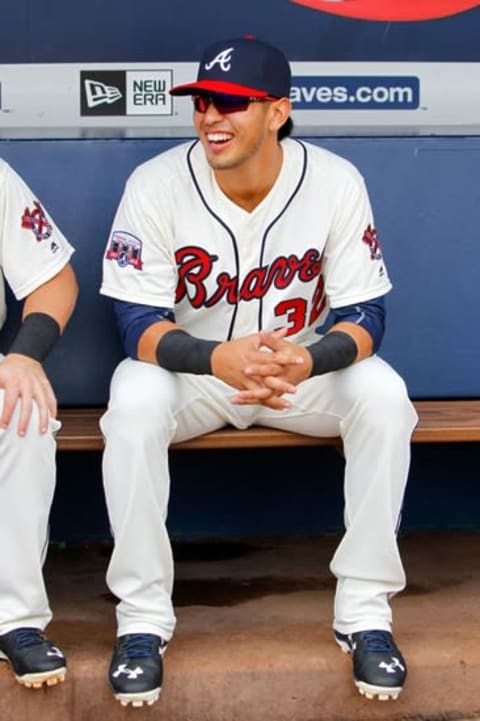
19. Rio Ruiz, 3B
Ruiz was one of the youngest players in AAA this season, yet he was one of the better players for a Gwinnett team that ended up in the International League championship. For emphasis on just how young Rio was for AAA, he only had 9 plate appearances the entire season against pitchers who were younger than he was.
Ruiz was acquired (among others) by the Braves in the trade that sent Evan Gattis to Houston (among others). Drafted out of high school in California, he had moved quickly up in the Astros system, and he had just played in the Arizona Fall League that fall before being acquired.
Ruiz struggled in his first season with the Braves organization in 2015 both at the plate and in the field. He had a rough BABIP attack early in the year, but he did some work with his swing in 2015 that really started to bear fruit in the last month and a half of the season.
Defensively, Ruiz has a tremendously different appearance in 2016 than 2015. I had some serious questions last year whether he would be able to continue at third without some major work at the position. Sure enough, he did exactly that, trimming off some bad weight and really working hard on his defense.
Ruiz is not still going to be a Gold Glove third baseman, but he has worked himself to the point where he is an above average defender with good range and definitely solid arm. His biggest advance was in his hands at third. He still has average to below-average instincts at the position, but he’s worked hard to improve those as well.
Ruiz has a smooth swing that he’s worked to add some loft finish to. That took a singles swing to at least a gap power swing. I do believe he’s got the natural strength that could lead to a 20+ homer guy, but I think he’s more likely to be a guy who hits .280 with 35+ doubles and 15ish home runs.
The big concern I still have with Ruiz at this point is the splits he has, and his swing has actually brought this out more. He had an .834 OPS against right-handed pitchers and .522 versus lefties. This is something still to work on, but he has made significant progress in his approach against lefties from a visual/scouting view, but the results haven’t shown up yet, so that could be coming.
Ruiz will likely be given an opportunity to work at third base in Atlanta whether that’s as the solo third baseman or in the strong side of a platoon with Adonis Garcia.
Next: #18 & #17
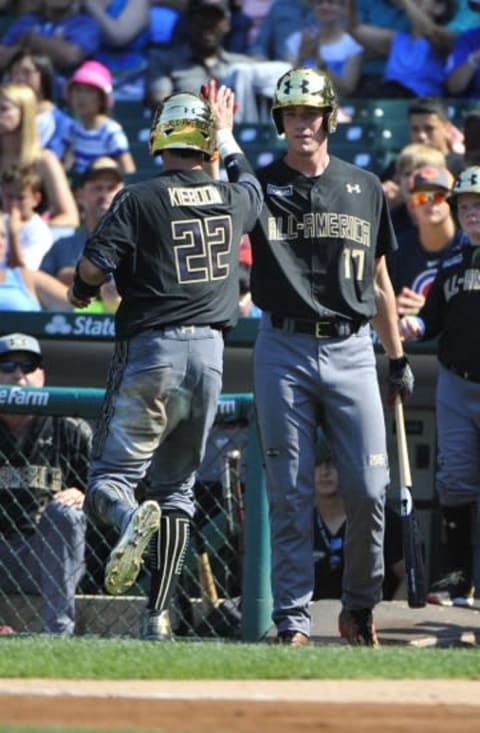
18. Joey Wentz, LHP
Those of you who follow my writing on Tomahawk Take know that I was cultivating as many opinions as I could get about the draft as I could find this spring. One of the rumors that began to come strong as early as late March was that the Braves were likely going to leverage their first two picks in order to get one of a deep crop of high school arms with their selection at #40.
When I was first talking with folks about this, the Braves were known to be very strong into two friends, Kansas high schoolers Riley Pint and Joey Wentz. I believe I put the combination of those two as my selections for 3 & 40 in at least one of my mock drafts, if not more. Well, I had half of that equation right.
One of the big concerns heard in the pre-draft process with Wentz was that his velocity had “taken a step back.” That was really not true whatsoever. Wentz was primarily a hitter, even early summer 2015’s showcase season, even winning a home run contest at one of the Under Armour All-American games. Late in summer showcase season, Wentz began throwing in showcases, using really only his fastball and curve, which allowed him to play up his fastball significantly.
Wentz sits with his fastball in the low 90s, but in short stints he can touch 96 with good plane from his 6’5 frame. He also has a curve with very nice break. What drastically played up in his pro time was his change that he definitely had some feel issues with going in and out during his time in Danville, but I got one report from GCL that Wentz’s change was his best showing in that scout’s view of Wentz.
Wentz did get hit around a bit in Danville, but a big part of that was working on his change and getting his arsenal right.
He will be going to Rome most likely to open 2017, and while he was the second pitcher selected in the 2016 draft, it wouldn’t surprise me if Wentz moves more quickly than Ian Anderson through the system, though I do believe Anderson has the higher upside.
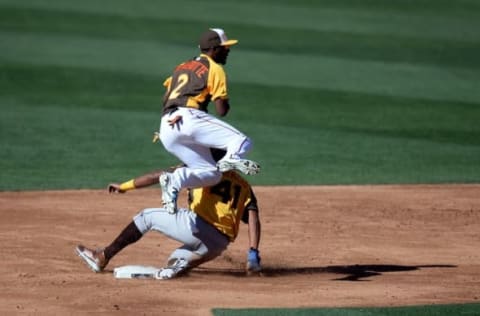
17. Travis Demeritte, 2B
Demeritte is a guy that may be the most volatile pick I had within my top 20. I feel like I could look back in a year and feel silly for either having him way too low OR way too high!
Demeritte has ridiculous athleticism with plus power and plus speed. He also has very good pitch recognition, but he also has a very interesting approach swing. He’ll frequently go up to the plate attacking, and he’ll end up flailing at poor curves and fastballs in the dirt.
Demeritte is an elite defender at second base. I believe that he could be elite at third base as well due to his arm strength. He’s been playing both positions in the Arizona Fall League and reports have been excellent on him.
I wrote up a report on Demeritte that I still believe strong in that compared Demeritte to Alfonso Soriano. I see this so much more as I watch him in the AFL facing a fairly elite pitcher consistently.
If you do have an opportunity to watch Demeritte in the AFL, please do. MLB.com has been playing a number of games on the website.
Demeritte will likely start 2017 in Mississippi, but the interesting question will be whether he will be at second base or third base. His ability to make consistent contact will be what determines how quickly he launches to the major leagues.
Next: #16 & #15

16. Lucas Sims, RHP
Sims has been a long-known name in the Braves prospect circles since being selected in the first round out of high school in 2012. Sims has been moving up progressively in the system, though he’s never had that “breakthrough” year that many have been looking for.
Sims started out the season very well for AA Mississippi, but things hit a road block when he got to AAA Gwinnett. From my viewings, he looked to be injured (specifically early on in his May 3rd start against Toledo) in the way his delivery favored one oblique side in his odd behavior from his typical delivery. That threw off his control drastically and his fastball straightened out badly, allowing him to be simply pounded (12 home runs allowed in 50 AAA IP vs. 3 HR in 91 AA IP).
Sims still utilizes a fastball/curve combination that would immediately be a dominant reliever combination if he went to the bullpen. When he gets off in his delivery, he does lose the arm side run that his fastball has.
Sims has a change that worked as above-average in AA, but really never showed well at AAA at all after that May 3rd start. He will likely be working his way back to AAA in 2017, looking to finish his progression to the Atlanta Braves.
15. Austin Riley, 3B
Riley was one of the prospects who showed big in fall instructs and got a lot of people talking. He ended up moving up a lot of ranks significantly in spite of real concerns about his strikeouts and defense, and when he came out and really struggled early in the season, I heard from a few people that he may not even belong in the top 20 of Braves prospects – and that was before the draft and IFA signings were added in!
Riley, to his credit, was working the entire time on his swing to get things right, first making an adjustment in the box and then adjusting his swing in order to close up a big hole in his swing lower-in, and he also was able to find a way to adjust where he stood in the box to be able to pick up velocity better.
I first really saw the effects of that swing work over Memorial Day weekend, and just for personal curiosity, I checked his numbers before and after that date. Here they are: through 5/27 (the Friday before Memorial Day weekend) – .229/.280/.367, 14 2B, 3 HR, 12/62 BB/K, 182 PA; from 5/28 on – .292/.346/.535, 25 2B, 17 HR, 27/85 BB/K, 361 PA.
Not only did he access his big-time power better from Memorial Day weekend on, he also bumped up his walk rate by almost a full percentage (6.6% to 7.5%) and lowered his strikeout rate dramatically (34.1% to 23.5%).
From Memorial Day on, the hitter we saw in Riley is a guy that should legitimately be in the top 10 of this prospect list, so why isn’t he? One big reason – defense.
Riley was drafted by the Braves as an off-the-radar hitter that many teams liked better as a pitcher. Due to that, the conversion to third base was seen to be a logical one, making use of his big arm. His first year was rough, but there were good reports on his work ethic out of instructs last fall, and the thought was that we’d see a big change this year.
We did, for about two weeks. Riley came into the season and really put significant time before each game taking infield, working on his reads on balls, working on his hands, making throws on the move, all things that he struggled with in 2015. However, when his hitting was suffering, defense took a back seat.
Honestly, it should for Riley. He’s not making the major leagues on the merits of anything he does with the glove, no matter what position it is. However, his defense by mid-season was making 2015’s showing look quite passable in comparison. He made 30 errors at the position in 2016, and I’ve seen some metrics that give him some positive defensive ratings, but those metrics also rate him highly because of the chances he fielded. Those were primarily due to a pitching staff that induced a lot of weak contact his way.
Riley really has filled out in his body and shown the defensive “meh’s” enough that a move to first base or corner outfield should be a strong consideration. Whether the Braves do it in 2017 or in the near future, that’s up for debate. Needless to say, if the CBA being negotiated this winter adds in a DH across both leagues mandatory at some point in the future, the Braves have their future guy already in house in Riley.
We’ll likely see Riley moved to high-A in 2017, and I’ll be curious how the team handles the defensive concern with him.
Next: #14 & #13
14. Cristian Pache, OF
More from Tomahawk Take
- Atlanta Braves 2023 Preseason Top 30 Prospects List: 11-15
- Braves News: Braves sign Luplow, Atlanta’s shortstop plans, more
- Atlanta Braves Could Go With Six-Man Rotation in 2023
- Atlanta Braves sign free agent outfielder Jordan Luplow
- Atlanta Braves 2023 Preseason Top 30 Prospects List: 16-20
Last summer, the Braves traded off a number of solid prospects (including one they got back this summer in
Caleb Dirks) for the finances to be able to afford both
Derian Cruzand Pache. The real prize at last summer’s signing date was supposed to be Cruz, the insanely athletic shortstop.
Instead, this year, it’s shown to be Pache, who is incredibly athletic in his own right with a cannon for an arm. He played well enough with GCL, hitting .283/.325/.377 with excellent speed and defense, but it’s after he was promoted to advanced rookie Danville that things took off for Pache.
The higher level of pitching didn’t seem to phase Pache at all, as he hit .333/.372/.404 and showed exceptional range and arm in the outfield. While the Braves have excellent defenders throughout their system in the outfield, Pache has been consistently talked about as one of the top 2-3 in the entire system after just his first year.
Pache does have more of a wrist-led swing. In the video you see posted, you’ll note that he is out on his front foot often in his swing. That does allow for better contact for him, but it also hurts him as far as generating power, and he certainly has the physicality that should lead into some power.
If I were putting grades on Pache from what I’ve seen of him, I’d probably have a current 55 on his contact with a future 60/65. He’s got 35/40 current power as he does get the ball to the gaps consistently, but he has 55/60 future power if he can pull back that swing and let his body and wrists work together. Add in an 80 grade arm and defense along with 65/70 grade speed, and you have a tremendously well-rounded ballplayer.
I’d wager Pache ends up in Rome to start 2017, but the Braves could be a bit more conservative with pushing him as he’ll just turn 18 in mid-November. He should be a guy that starts to make a lot of noise on the national level in 2017, though.
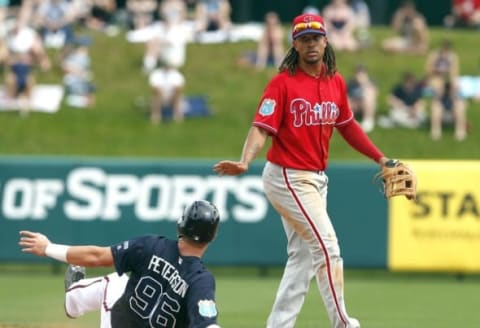
13. Dustin Peterson, OF
Peterson was one of my guys that I hung my hat on last year, barking about how great he looked before the bus crash in Carolina, and how he just wasn’t physically right the rest of the season, so to be wary of judging his 2016 based on the full season of 2015.
Instead, he took care of that himself, being one of the most discussed outfielders in the Southern League this summer, perhaps behind only Tyler O’Neill.
Peterson hit .282/.343/.431 this year with 38 doubles (2nd in the Braves system) and 12 home runs. In a theme of the Braves’ system, Peterson hit all of 18 times against younger pitchers in 578 plate appearances in 2016.
Peterson is a big, athletic guy, listed at 6’2, 210, but probably closer to 225, but very athletic in that 225. He’s got a great arm, not plus, but a fringe above-average arm in strength that he is very accurate with to make it certainly play above-average.
Peterson is a guy who shows very good speed on the field, but he does take a step or two to get to top speed, so he likely won’t be a guy who ever steals 20 bases, but he will be a guy who is an asset on the bases and gets to a lot of balls defensively.
I’ve personally been a big, big fan of Peterson’s defense in left field. He’s able to cover a lot of ground with long strides and has good reads right off the bat. Offensively and defensively, I’ll continue to compare him to Alex Gordon until it stops fitting so gosh darned perfectly!
Peterson will likely start out at AAA in 2017, but should get a taste of big league spring training and could force some interesting decisions with the veteran outfielders if he keeps playing well.
Next: #12 & #11
12. Patrick Weigel, RHP
Weigel leaped forward this year after being drafted in the 7th round out of University of the Pacific. Weigel was known for his velocity…and not much else. He threw four pitches, but his control of any of them was in question, and he struggled with exactly that in Danville in 2015, so there were many who figured his 2016 would end up in the bullpen.
Instead Weigel made significant strides in repeating his arm slot, which is a low 3/4 slow that resembles where a third baseman would sling the ball across the diamond. That arm slot is often difficult to repeat, but Weigel did very well with that.
His biggest issue in 2016 was his change. The curve and slider both played very well, and with his elite fastball, they give him an excellent foundation to move forward, but his step forward from mid-rotation starter to an elite starter that could be an ace in the entire game.
In the scouting report I did on him in September, I compared Weigel to Max Scherzer in the velocity and break on their pitches when Weigel is on and with the arm slot as well. If Weigel can polish that change, he can make the strides that Scherzer did from a thrower with good breakers to a guy with four excellent pitches and elite control.
Weigel has a strong body and certainly can handle the workload, throwing just short of 150 innings this year and having thrown a little over 100 the year before. I’d wager he’ll sit in AA to start 2017, but he could move quickly if he keeps up his 2016 performance.
11. Touki Toussaint, RHP
Touki is a guy with an absolutely elite curve that the Braves stole from the Diamondbacks in 2015 because they were willing to take on salary from Arizona.
Toussaint’s first season with the Braves was, to be kind, ugly. He posted a 5.73 ERA and had nearly as many walks as he did strikeouts.
The Braves have been working with Toussaint to focus his work on his fastball and solid change to work low in the zone on hitters and get them to roll over on those pitches early in counts and use his ridiculous curve more to finish off at bats rather than as the prime pitch in at bats. They also worked with Touki on some adjustments in his delivery to allow him to be consistent in the delivery, a major issue in his control
This year, you saw early that Touki was struggling with his new pitch sequence and delivery early on. His month by month ERAs were 9.19 in April, 4.61 in May, and then 2.17 in June. From June 1st until the end of the season, Touki threw 89 1/3 innings with a 2.72 ERA, 1.23 WHIP, and a 43/104 BB/K ratio.
Touki has some of the best raw stuff in the entire system, and he started to show it as the season wore on in 2016. Consistency is his next goal, as he did have his share of ups and downs within starts, and as he can get consistent within starts in his approach, he’ll have that chance to get to an elite prospect in the entire game.
Toussaint will likely move to high-A to open 2017, and he’ll be a guy that they look to keep progressing in his sequencing and attacking hitters early in counts.
Next: Braves Minor League Database
I hope you enjoyed the list so far! This afternoon comes the top 10!!